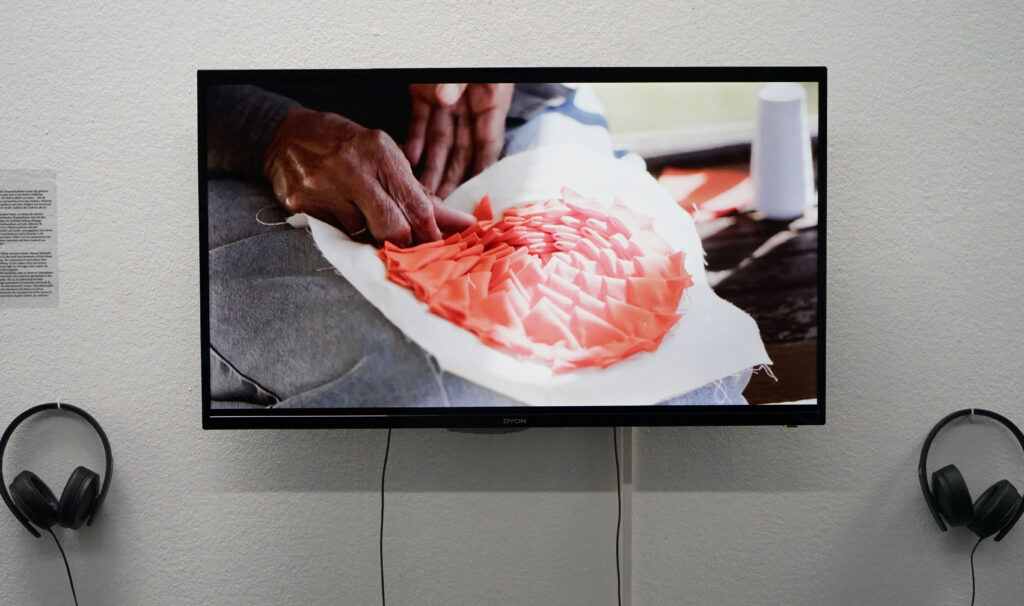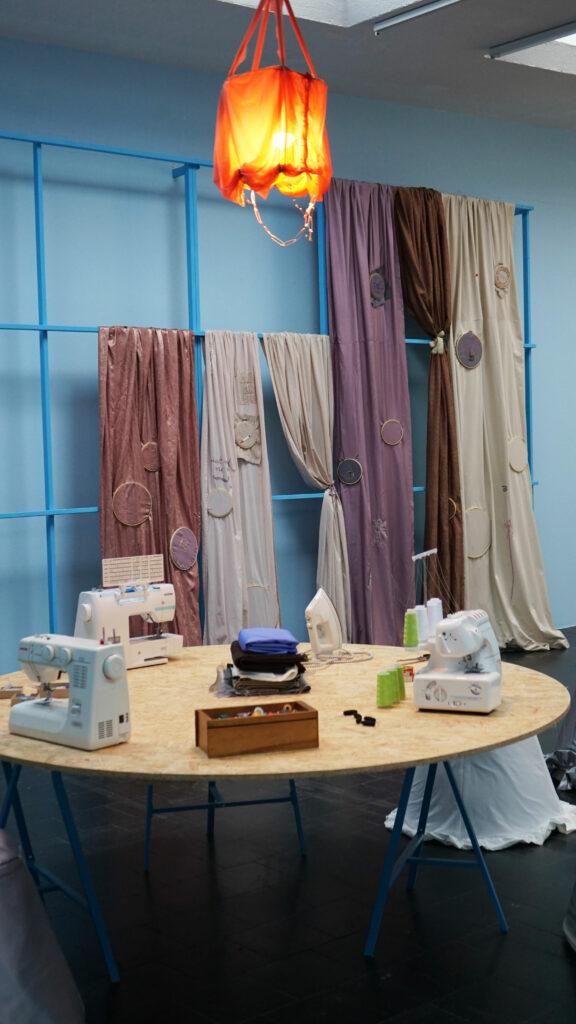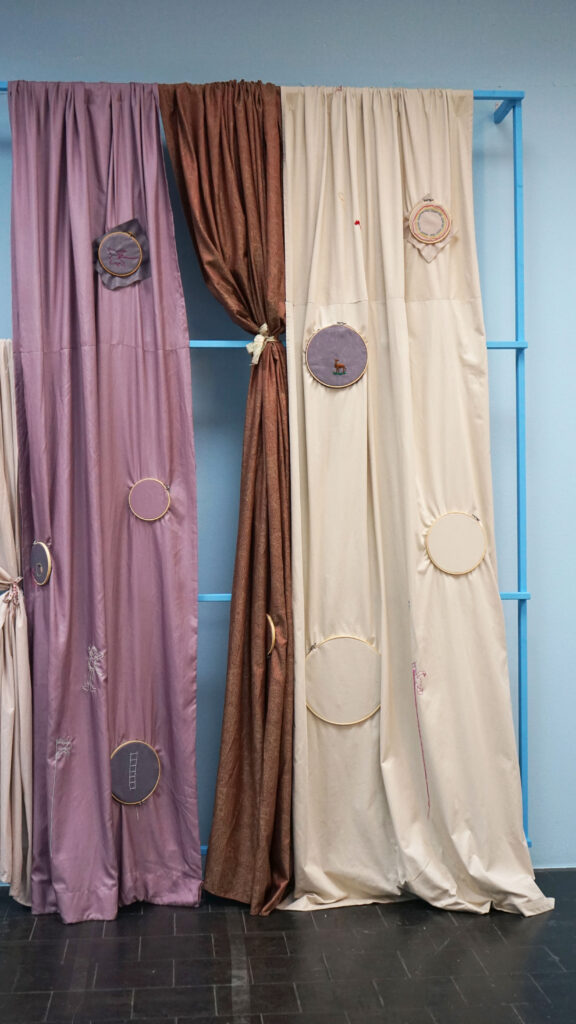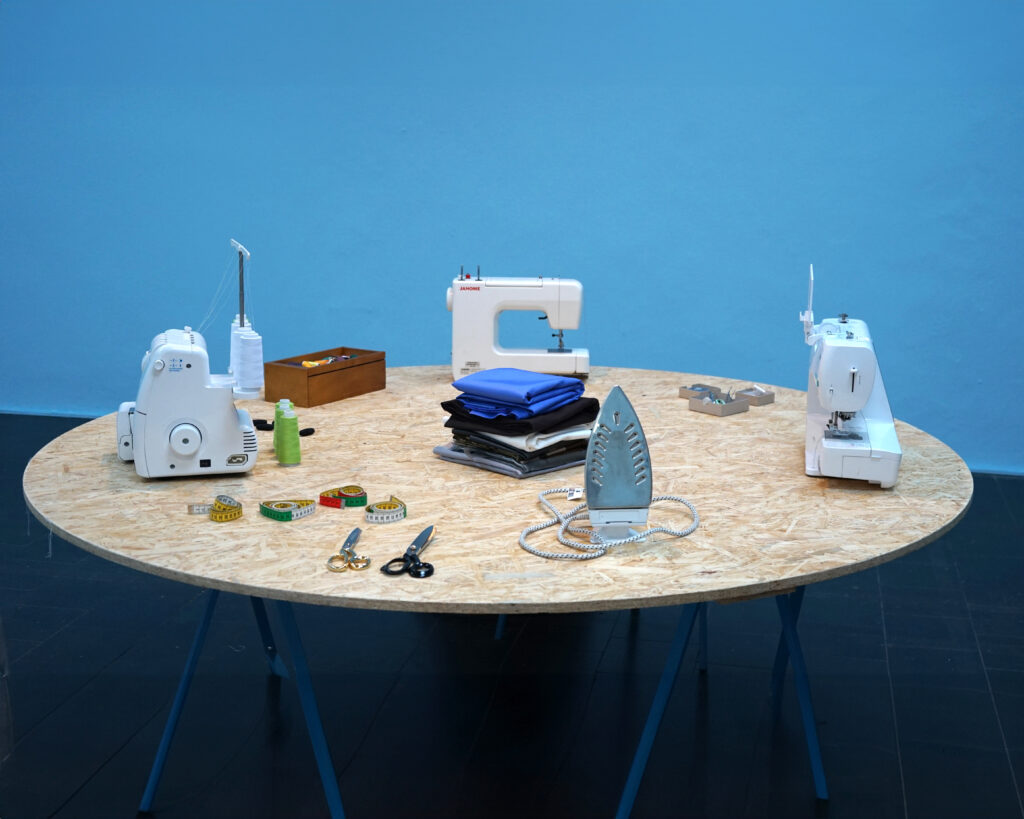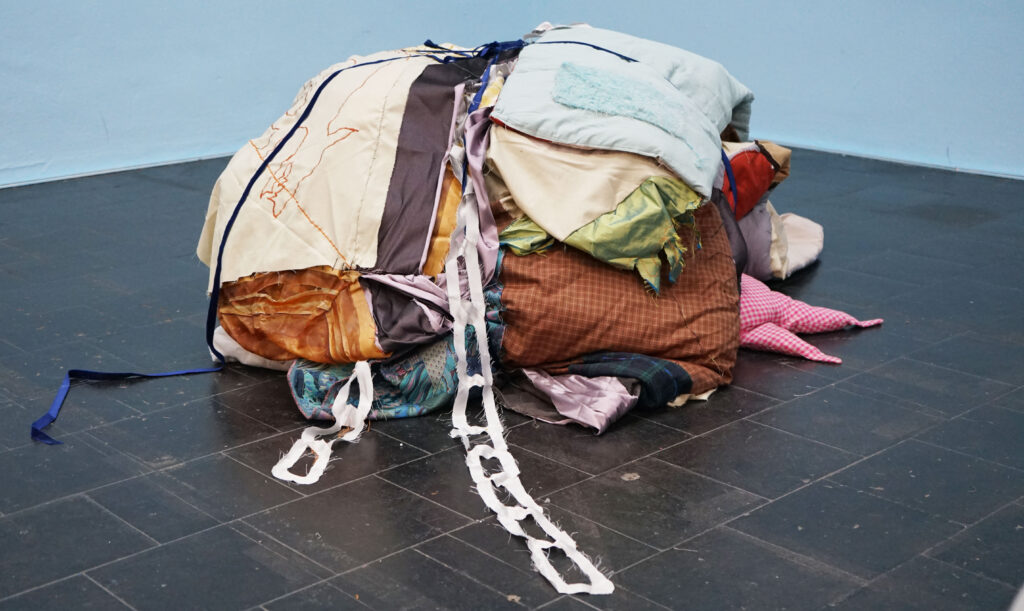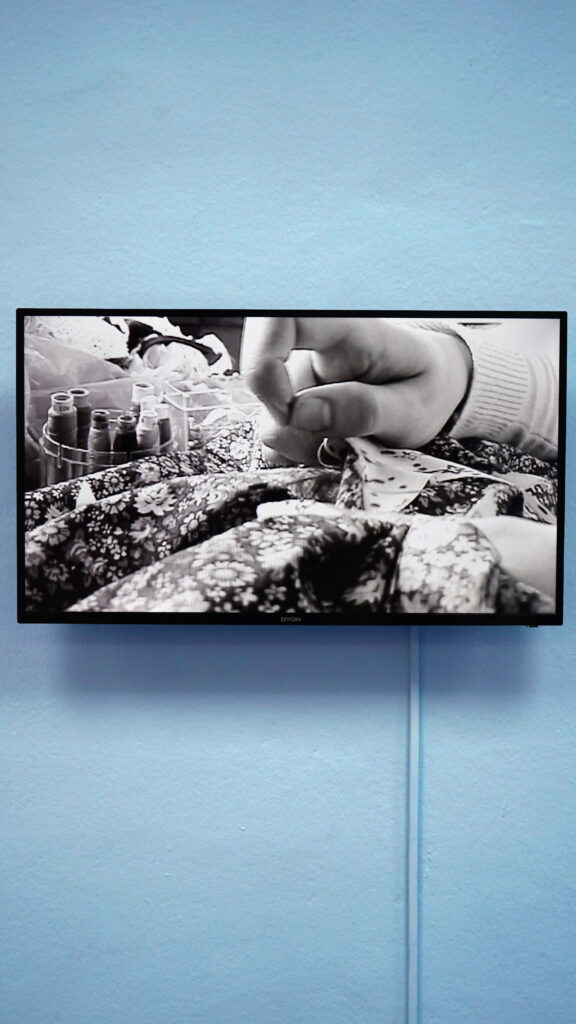BLUE BINDING RIBBON
Common Threads Press, Maris Curran, Nina Danino, Brigitte Dunkel, Fashion House Limanka, Maria Renée Morales Garcia, Nora Hansen, Laura Huertas Millán, Stephan Idé, Olena Newkryta, Marzena Nowak, Nie Pastille, ReSew sewing cooperative, Sarah Ferreira dos Santos, Working Textiles (Alissa Ritter, Karla Kleinschmidt, Marie Schubert, Sofia Magdits Espinoza), and others
13 April — 2 Juni 2024
Opening: Fri 12 April, 7 p.m.
Curated by Lisa Klosterkötter and Aneta Rostkowska
Exhibition design by Jakob Engel
Blue binding ribbon includes a processual exhibition and a series of workshop formats, guided tours and discussions. The project revolves around collective aspects of textile handwork in the visual arts. Its main inspiration are current and historical cross-feminist working groups, collectives, self-help gatherings, studio communities, schools, platforms and digital networks that focus on the joint production of artistic works and handicrafts.
The starting point for the exhibition is, among others, Schule des Kreativen Feminismus (the School of Creative Feminism), founded in Cologne in 1979 by the artist Ulrike Rosenbach. An empty shop located at Venloer Straße 21 was used by the initiative as a space for exchange, workshops and collaborative work. The cover of the zine “Examples of autonomous cultural work” published by Rosenbach in 1980, which contains a retrospective, a text and documentation of the School, shows 11 pairs of hands whose fingers are wrapped in wool yarn of various thicknesses and colors. The hands lie in a circle with their fingers facing each other and resemble a newly covered physical weaving frame and which, with a first - blue - thread coming through the center, makes a beginning for a fabric and for the connection between all the hand owners. This motif ties in with the title of the exhibition Blue binding ribbon in insofar as in both cases metaphors from the world of handicrafts are used to visualize community, solidarity and collectivity. The tying, binding, binding, bringing together, connecting by means of a binding (a sewing band that binds, borders, seams and reinforces raw, unfinished parts of a fabric) alludes to the collective aspects of craft making.
In the course of the exhibition, two collectives will occupy the space and develop projects. One of them, Working Textiles, was founded in October 2022 by five students of the Art Academy of Düsseldorf: Marie Schubert, Alissa Ritter, Sofia Magdits Espinoza, Karla Kleinschmidt and Helene Kuschnarew. Working Textiles is an open textile workshop, and an exchange platform establishing a non-hierarchical meeting point that enables the transfer of textile skills and knowledge within and outside the Academy. Throughout one year, trying to compensate for the absence of a textile workshop at the school, Working Textiles organized meetings and workshops that took place in the hallway in front of room 121 in the Art Academy of Düsseldorf. Then, with the support of the funding on the occasion of the 250th anniversary of the Art Academy, they moved into their own space which, from September to November 2023, was transformed into a textile workshop and a place for collaborative work, equipped with various machines and materials. From there, Working Textiles organized workshops, artist talks, and various events like a pop-up store, a runway screening, a thrift shop, and a dinner, stimulating the discourse about textiles and its different connections and connotations. By closely working together and meeting regularly, a network was created that provided support in times of global crisis and opened a space to counteract isolation and alienation.
The second collective working in the space is a temporary one - an experiment created specifically for the time of the exhibition. Brigitte Dunkel, Maria Renée Morales Garcia, Nora Hansen, Stephan Idé, Nie Pastille, and Sarah Ferreira dos Santos will regularly meet at the CCA Temporary Gallery and undertake common activities to be presented during the final event on the 1st of June (Save the date!). Existing textile works of their authorship are exhibited, including embroideries, tapestries, textile paintings, patchworks and costumes. They form a starting point for a new collaboration within the framework of the temporary collective, developing in dialog with the respective contexts of these individual works. Additionally, the artists involved in the project will offer various workshops throughout the exhibition time and share their skills with the community of the Temporary Gallery. The goal is to offer an open space for creative development processes and thematic discourse, share techniques and materials.
Another collective project presented in the exhibition space is a result of Temporary Gallery's youth education program, coordinated by Ana Manhey Ahrens and Paloma Nana. Since October 2023, the CCA Temporary Gallery has been collaborating with the Katharina Henoth Comprehensive School in Cologne-Vingst. Together with the art teacher Tinani van Niekerk and the artist Joséphine Sagna, a series of lessons on the themes of fashion, identity and representation was conducted. The students designed their own clothing for a fictional character which resulted in a powerful, enchanting and lively collection of garments.
Blue binding ribbon aims to highlight and strengthen the communal aspect of craftsmanship in connection with its political and therapeutic aspects. Textile work can build a bridge between people from different generations, cultural circles and classes. In our social media age, when we are increasingly physically distant from each other, crafts are a protection against isolation and a way to stay connected. They not only strengthen our sense of self, but also our sense of belonging. Craft making connects the future and the past: to sew something for yourself is to believe in your future self, to have hopes. It offers a way to reject perfectionism - embrace the imperfect and the human (what you produce yourself will after all never be perfect) and explore new aesthetics. The world of craftsmanship is more inclusive than the art world, more seems allowed and accepted. The main focus is on the joy of creating and the opportunity to connect with other people. Crafts also have a special healing power: there are many studies that examine the connection between creativity and well-being. The mesmerizing immersion in the craft results in relief from inner turmoil. The sense of achievement can boost mental health and our immune systems as relief from the pressure of multitasking is replaced with focus on one thing. Crafts are even increasingly recognized as an effective way to combat depression.
During the pandemic, many people started getting involved in making things. Now is the time to come out of isolation and share what you learned at home with the others. In the context of the younger generation increasingly losing tactile proximity to materials such as paper, paint, clay, fabric, wood, etc. due to digitalization processes, handcraft offers a potential to help young people to regain the domain of the tactile and develop their creative abilities.
In her book “Post-Growth Living: For an Alternative Hedonism” (Verso 2020) Kate Soper highlights the political potential of craft making in the context of new forms of pleasure and hedonism emerging in the times of climate crisis. She writes that craft ways of working “(...) by reason of their emphasis on skill, attention to detail, and personal involvement and control, run counter to prevailing views on the mental–manual division of labor with its imperatives to adhere to the work-and-spend economy. In a slower paced society, in which people had more time to provide for themselves, artisan production could expand and many more could benefit from the skills, the mental concentration and the satisfaction it can provide. (...) artisanal ways of working might be reclaimed as a component of an avant-garde, post-consumerist political imaginary, rather than dismissed for their association with pre-modern social relations and limits on pleasure. (...) The artisan ethos has an obvious affinity with newly emerging anti-consumerist trends and networks: with the new interest in ‘slow living’ that is being registered in the USA and Europe, and the formation of campaigning networks linking those who have opted for ‘downshifting’ and more sustainable lifestyles. (...) Craft methods and ‘slow-working’ are eminently compatible with communally owned enterprises and cooperatives and, indeed, with any organisation of labour freed from the demands of making as much as possible in the shortest possible time. ‘Craftivism’, as the political wing of the craft movement is known, is now actively associating craft with escape from the prevailing codes of mass consumerism.”
A unique exhibition design by Jakob Engel is a hybrid between an exhibition part, a setup for artworks, and an open studio part, a constellation of everyday objects and furniture that is actively used in events and workshops. The idea is to create an open space that offers anyone interested the opportunity to work with materials on site, try out various handicraft techniques such as sewing, embroidery, crocheting, darning and mending, or that, during the gallery’s opening hours and at special events to share your own skills with others and to intensify them for yourself. One of the design elements is a grid, resembling a modernist one, that in the exhibition will be “broken” with different artworks, textiles and flatscreens. In this way the legacy of modernism, industrialisation and alienated labor (also in the sewing industry) is questioned on the level of space design. Large work tables and material shelves are centrally located in the exhibition room and can be accessed and used by visitors and working groups. The lighting situation is designed in such a way that the exhibited works are given their space and at the same time a stimulating working atmosphere can be created. Some of the furniture is made from leftover materials from past projects and some are newly built for long-term use in the gallery and can also be used in a variety of ways after the exhibition. A mini canteen with the mobile kitchen of the Temporary Gallery has been arranged for the „workers'' to support their exchange and working processes.
With its emphasis on the collective aspect of craft making the exhibition also refers to the history of the space of the Temporary Gallery which - as a former storage for replacement parts for factories active in the city center of Cologne - is connected to the industrialization process of the region. This time however an attempt has been made to return to a non alienated and embodied form of collective labor. Blue binding ribbon becomes in this way a symbol for a possible emancipation of blue-collar workers, this time entering the blue screen that enables other labor conditions, very much in the spirit of the imaginative ending of Olena Newkryta’s film presented in the exhibition: „With your eyes closed, imagine an inoperative community, an exhausted community, and a community of the exhausted. A community, however, that can still act. Not because it is entitled to do so, but because as a community of convalescents we realise in an empty moment of full awareness that we care.”
Images:
1—Marzena Nowak, Untitled (UE), 2004
2—23 Blue Binding Ribbon, (installation views), Temporary Gallery, 2024
Funding and Support:
Ministerium für Kultur und Wissenschaft des Landes Nordrhein-Westfalen
Kulturamt der Stadt Köln
Deltax contemporary
Hotel Chelsea
The youth project has been generously supported by RheinEnergie-Stiftung and Commerzbank-Stiftung.













